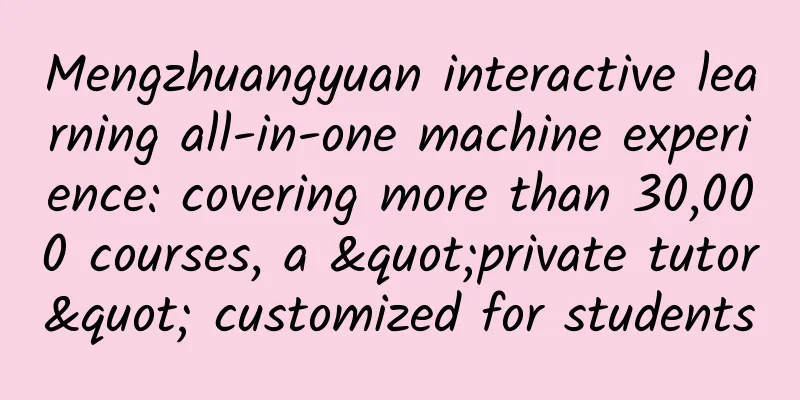[Li Jiaoshou] How to formulate a program-based marketing plan?
![[Li Jiaoshou] How to formulate a program-based marketing plan?](/upload/images/67cc19c63839b.webp)
|
There are two types of marketing plans: one is an "outline plan" and the other is a "program plan". Outline planThe vast majority of marketing plans I have seen are such “outline plans”. For example, the anniversary marketing plan of a shopping mall in Beijing:
At first glance, such a plan seems to have a lot of room for imagination ("tens of thousands of visitors", "tens of millions of spreads"), but on second thought, it always feels like something is missing. What went wrong? The biggest problem with this kind of "outline plan" is that it doesn't solve any problems. This plan merely listed what a marketing plan generally does, but did not mention what our key issues were or how to solve them . Rather than a "marketing plan", it is more like an "outline that is obsessed with target details and task templates" and can hardly effectively guide anyone's specific work. For example, if one of the important parts of the plan is “viral videos,” then I would like to ask: Are all viral videos okay? What role does the viral video play in the whole plan? What theme should it fit? Why do you need a video? In fact, by modifying the date and company name, the entire plan can be fully applied to almost any marketing activity of any product. The crowdfunding plan for smart hardware, the launch plan for new mobile phones, the packaging change plan for Melatonin, the movie distribution plan, and even the Fengjie hype plan can all be fully applied with this outline template : attracting target customers, online and offline linkage, bus and subway advertising coverage, H5+ video viral transmission , KOL forwarding, and tens of millions of Weibo discussions... But what’s the use of this? When you add “tens of millions of spreads” to PPT, can it help the entire event spread to tens of millions of people? Another type of plan is the very rare "scenario plan" . Program-based planningProgram-based planning treats plan making as a process of "finding a solution to a problem". Its goal is to solve a problem through a series of marketing actions, rather than simply listing a list of tasks that "need to be done but have not been done". For example, the same mall anniversary plan mentioned above may be written like this:
Outline planning vs scenario planningWhat is a plan? In fact, I really don’t like the word “plan”. Simply saying “make a plan quickly” sounds like it’s as simple as making a to-do list, deadlines, and task goals. The rest is easy. Just search on Baidu Wenku and you will see several typical marketing plan templates. Then, by combining some trendy marketing terms with classic management principles, you can easily put together a PPT of dozens of pages. For example, these fashionable marketing words: "integrated marketing communication", "explode the whole network", "KOL forwarding", "H5 interaction"... Apply these classic management theories: Gantt chart, responsibility system, time nodes, assessment standards... But this is not the "plan" that most companies really need; it is just a list of good wishes. In fact, planning should be a way to achieve good wishes, rather than the good wishes themselves. When someone says, "Help me make a plan," what they really mean is, "I'm facing a series of problems right now. Can you help me figure out how to use the company's resources to solve these problems?" Instead of thinking, “Honey, I don’t know what marketing wishes are (like “break the Internet”), can you tell me some?” So, what is a “plan”? I think of “planning” as “designing a sequence of key actions to solve some problem.” It's more of a "solution" than a "plan". (Why outline planning is unreliable, because it is not a solution to some problem, and it doesn’t even know what the problem is.) What is a Marketing PlanSince the essence of a “plan” is a “solution to certain problems,” what is a “marketing plan”? A marketing plan is actually a "solution to customer perception problems." This is a bit confusing, let me explain. We assume that an enterprise has two types of assets. One type of asset is the assets within the enterprise, such as: team, office, company cash flow, products, etc. The other is an invisible asset that exists in the minds of many customers, such as: "Customers think our products are of good quality", "We are the second brand customers think of when shopping", etc. In the past, we believed that a company’s most important assets were within the company. In fact, a company’s most important assets are outside the company, in the perceptions of a large number of customers. If financial planning and operational management planning are used to solve the problem of internal assets of the enterprise, then the marketing plan is to solve the problem of the external asset of "customer cognition":
In short, you want to "change some of the consumers' thoughts, attitudes, and behaviors to make the situation more powerful for you," and to do that, you need to develop a marketing plan. How to make a marketing plan Since a marketing plan is a series of actions designed to solve customer perception problems, a program-based plan should at least meet these conditions, compared to the popular outline-based plans:
1. Identify the problem you want to solve Any plan must state "what problem to be solved" and "how to solve the problem". If the problem is not clear, then any task list is meaningless. For example, I once met a decoration company. Seeing that everyone was running a WeChat community , they wanted to run one too, but they were struggling to find the right method. "My WeChat group is often active for a period of time but then becomes inactive. How can I extend its life cycle?" Since we need a " community operation " plan, we should first look at "why you need to operate a community". “Of course I want more people to buy my renovation services.” Since “we want to get more customers”, what is the key issue? Why don’t many customers buy your services? Is it because they lack a community with sustainable vitality? Of course not. Decoration itself is a task that only happens once every ten years or so. Most people will pay close attention to such topics during the decoration period, but once it is completed, they will no longer care about it. In this case, the key question should be: How can I make target consumers think of me when they want to decorate their homes? The "sustainable vitality" plan is obviously of no help to this problem - once everyone has decorated their houses, they will no longer pay attention to decoration topics. At this time, what is the point of trying so hard to get others to chat in a "decoration" group? (Of course, if it is a product that is purchased repeatedly like Coca-Cola , it still makes sense.) Many times, we just tap on the keyboard and write "H5 interaction", "explode the entire network", "viral video" in the short-term marketing plan, and write "increase WeChat fans", "continuous operation of Weibo" and so on in the long-term plan, but we forget to figure out what problems we want to solve through these plans. For example, the mall anniversary plan initially proposed in the article did not explain what problems were currently being faced or how to solve them. It only listed some routine activities that had been done in the past. Therefore, any marketing plan must begin by stating: What is the key problem we are facing now and why the plan I am going to talk about next can effectively help solve this problem. If you can't say this, then you are probably doing "outline planning" and copying some common practices in the industry. If the only reason you do something is that other people are doing it, you certainly can't say "what key problem you want to solve." 2. Focus more on the process rather than the goal Many times, when you open a marketing plan, you will find that most of it is a list of goals - H5 dissemination, detonating the entire network, viral videos. It is undeniable that the existence of goals and aspirations is very important. But it is the way you achieve your goal that matters most, not the goal itself . For example, "viral video" is not actually a way of making videos, but a goal that the video wants to achieve. Videos with a large spread are naturally viral videos, and videos with a small spread are not true viral videos even if they are named "viral video" as a project. Using "viral video" as a plan for dissemination is as nonsense and useless as writing "cook a delicious dish" into a chef's recipe - "cook a delicious dish" cannot provide any substantive guidance to the chef, it is better to simply say "add more salt". Therefore, the plan should focus more on the process and should be a description of "how we should solve the problem" rather than simply depicting good wishes. After all, when a person says "he lacks a promotion plan", he doesn't mean "he doesn't know how good the marketing goals can be", but "he doesn't know how to do it". Similarly, we need a plan not because we are worried that "our goals and aspirations are not big enough", but because we are worried that "our next actions lack a clear guideline." 3. Design actions for users, not yourself Most outline marketing plans tend to start from the company’s own actions (for example, I want to make posters, I want to make H5), rather than from the user’s actions (what ideas do I want users to have). In fact, just as a war battle plan needs to include more "enemy actions" rather than the actions of one's own army, a marketing plan should include more of the user's thoughts and actions. To do this, the marketing plan needs to answer these questions:
4. Comply with the principle of economy What is the "economy principle"? It means that you are "better" at doing this than anyone else. For example, if you are a person who sells "smart water cups", then the effect of daily Weibo activities may be very low (smart water cups are durable products, not daily consumables like Durex , and cannot rely on daily interactions to stimulate repetitive purchases), so you are not as suitable as Durex. Therefore, the effect of concentrating on large-scale dissemination at one time may be very high. In fact, if we regard plans as "solutions", any solution needs to reconsider "economics" - in order to solve my problem, what values are overestimated and what values are underestimated? For example, when Li Jiaoshou’s team was just established in July last year, they wanted to recruit designers. One of the original plans was to go to 4A companies to find excellent designers. This plan was rejected because it was not economical: it is good to have excellent designers in 4A companies, but it is actually a waste - they have some skills that we do not need (such as the ability to make pictures extremely complex, gorgeous and exquisite), because we focus on content and require pictures to be clear and text to be prominent, so we do not need such a high level of photo editing skills. At the same time, there are some abilities we need that they may not possess, such as occasionally helping with video editing and making PPTs. This means that we are no more suitable than these 4A companies to hire these talents. Assuming that this person's salary is 30,000, then at least 15,000 is used to pay for some skills that we don't need (such as superb photo editing skills). Eventually we found someone who was a better fit elsewhere. In short, there are countless solutions to any problem, and the person who makes the solution must explain why this solution is more suitable than other solutions and why his company is more suitable for this solution than other companies. For example, I was attending a discussion meeting before to help a food company come up with a promotion plan. Someone suggested, “We can cooperate with Alipay to do offline promotion !” This is certainly a good idea, but it doesn’t actually solve any problems. Because you can cooperate with Alipay for promotion, then others can too (including your competitors). You haven't explained why your cooperation with Alipay is more effective than others. Similarly, there are many ways of communication, such as H5 communication, WeChat operation , Weibo interaction, viral videos, offline advertising, etc. If you write them all into the marketing plan, do you want to invest resources evenly in all of them? Of course not. In reality, you can only focus your resources on the channels that will best help solve your key problems. (For example, “continuous purchase and attention” is not the key issue for the decoration company mentioned above, so operating a continuous user community may not be very meaningful.) ConclusionMost marketing plans tend to describe some beautiful goals (we want to spread the word to tens of millions of people) or list a lot of things to do (such as setting up the event venue before the 21st). These are of course very important, but the most important thing is to return to the reason why we make plans: We have a problem, now we need to design a series of actions as a solution! Why do I think that spending a lot of effort on estimating reach is far less important than the design process itself? Perhaps this is due to the nature of marketing. I believe that marketing is both a science of certainty and an art of possibility. It is called a "deterministic science" because the public psychology is actually very stable, and there are so many psychological methods. As long as there is enough research and user insights , you will definitely find a more appropriate solution to the problem. It is called the "art of the possibility" because although you can choose the best method, the final result is often difficult to estimate - you are sure that you have designed excellent copy, but it is difficult to estimate whether the final dissemination volume will be 1 million or 10 million, and how much the conversion rate will increase. That is, you can often choose the process, but it is difficult to control the outcome. It's like educating children. You know clearly that "it is better for children to go to school than not to go to school" (deterministic science), but you don't know whether they can become a CEO or something else after going to school (the art of possibility). Since "marketing is both the science of certainty and the art of possibility", naturally, we should spend more energy on the science of certainty (thinking about what should be done specifically) rather than all of it on the art of possibility (busy fantasizing about ultimately achieving a communication effect of tens of millions or millions). This article was compiled and published by @李叫兽 (Qinggua Media). Please indicate the author information and source when reprinting! Product promotion services: APP promotion services Advertising |
>>: Case analysis: Deconstructing the gameplay of community operations!
Recommend
6 flagships comparison: Galaxy S6 beats iPhone 6
The Galaxy S6/S6 Edge has not only made great imp...
Google VP criticizes Apple iMessage for "green bubble bullying" of Android users
On the morning of January 8, the Wall Street Jour...
Photography O2O is on the rise and the scope of gold mining is gradually expanding
Judging from the current status of the traditiona...
Alibaba's autonomous driving route begins to take shape: Wang Gang leads the team, L4 takes the lead
The rumors began to be verified more and more. Th...
Half of Chinese people are infected with Helicobacter pylori. Huaxi doctors: If you don't pay attention to this during the Chinese New Year, you are most likely to get
Happy New Year 🎉 Workers returning home The dinne...
Illustration | Are you still worried about "snow" in April? This picture tells you how to do it in the most scientific way!
April is coming to an end. Did it snow in your Ap...
How should young people prevent cancer?
In recent years, the incidence of cancer has beco...
The "new version of traffic lights" circulated on the Internet makes people anxious, and what makes people even more anxious is the red lights all the way...
Yesterday, the topic of "new version of traf...
Ancient fruit preservation: How dare you let the queen eat rotten melons?
Produced by: Science Popularization China Author:...
Tips for operating a wedding photography video account!
1. What is Video Account? Short content : It is a...
These "little bumps" on your body are health alarms! If there are changes in these 4 parts, go to the hospital immediately!
Recently, according to multiple media reports, ve...
Do insects have emotions?
© BBC/Alamy Leviathan Press: Personally, the ques...
Double Eleven video material creative guide!
This article brings you the "11.11 Video Mat...
World Bank: 2022 China Country Climate and Development Report
The China National Climate and Development Report...
Airlock, small robotic arm, flexible solar wing - Analysis of the "unique artifacts" of the Wentian Experimental Module
Xinhua News Agency, Wenchang, Hainan, July 24 Tit...



![[Artificial Intelligence] There is a "double agent" in life, do you know?](/upload/images/67f1e035242c7.webp)





